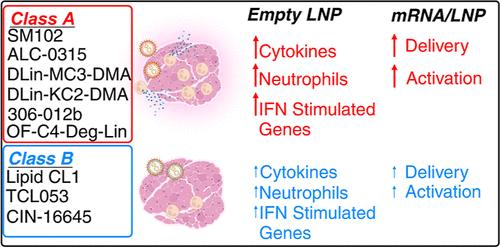Distinct Inflammatory Programs Underlie the Intramuscular Lipid Nanoparticle Response
IF 16
1区 材料科学
Q1 CHEMISTRY, MULTIDISCIPLINARY
引用次数: 0
Abstract
Developments in mRNA/lipid nanoparticle (LNP) technology have advanced the fields of vaccinology and gene therapy, raising questions about immunogenicity. While some mRNA/LNPs generate an adjuvant-like environment in muscle tissue, other mRNA/LNPs are distinct in their capacity for multiple rounds of therapeutic delivery. We evaluate the adjuvancy of components of mRNA/LNPs by phenotyping cellular infiltrate at injection sites, tracking uptake by immune cells, and assessing the inflammatory state. Delivery of 9 common, but chemically distinct, LNPs to muscle revealed two classes of inflammatory gene expression programs: inflammatory (Class A) and noninflammatory (Class B). We find that intramuscular injection with Class A, but not Class B, empty LNPs (eLNPs) induce robust neutrophil infiltration into muscle within 2 h and a diverse myeloid population within 24 h. Single-cell RNA sequencing revealed SM-102-mediated expression of inflammatory chemokines by myeloid infiltrates within muscle 1 day after injection. Surprisingly, we found direct transfection of muscle infiltrating myeloid cells and splenocytes 24 h after intramuscular mRNA/LNP administration. Transfected myeloid cells within the muscle exhibit an activated phenotype 24 h after injection. Similarly, directly transfected splenic lymphocytes and dendritic cells (DCs) are differentially activated by Class A or Class B containing mRNA/LNP. Within the splenic DC compartment, type II conventional DCs (cDC2s) are directly transfected and activated by Class A mRNA/LNP. Together, we show that mRNA and LNPs work synergistically to provide the necessary innate immune stimuli required for effective vaccination. Importantly, this work provides a design framework for vaccines and therapeutics alike.

不同的炎症程序是肌内脂质纳米粒子反应的基础
mRNA/脂质纳米粒子(LNP)技术的发展推动了疫苗学和基因疗法领域的进步,同时也引发了有关免疫原性的问题。虽然有些 mRNA/LNPs 能在肌肉组织中产生类似佐剂的环境,但其他 mRNA/LNPs 在多轮治疗递送能力方面却各不相同。我们通过对注射部位的细胞浸润进行表型分析、跟踪免疫细胞的吸收情况以及评估炎症状态,来评估 mRNA/LNPs 成分的佐剂性。将 9 种常见但化学性质不同的 LNPs 运送到肌肉后,发现了两类炎症基因表达程序:炎症(A 类)和非炎症(B 类)。我们发现,肌肉注射 A 类而非 B 类空 LNPs(eLNPs)可在 2 小时内诱导大量中性粒细胞浸润肌肉,并在 24 小时内诱导多种髓细胞群。令人惊讶的是,在肌肉注射 mRNA/LNP 24 小时后,我们发现肌肉浸润的髓样细胞和脾脏细胞被直接转染。肌肉内转染的髓样细胞在注射 24 小时后表现出活化表型。同样,直接转染的脾脏淋巴细胞和树突状细胞(DC)也会被含有 A 类或 B 类 mRNA/LNP 的细胞激活。在脾脏 DC 区间,II 型常规 DC(cDC2s)直接转染并被 A 类 mRNA/LNP 激活。我们的研究结果表明,mRNA 和 LNPs 能协同提供有效接种所需的先天免疫刺激。重要的是,这项工作为疫苗和疗法提供了一个设计框架。
本文章由计算机程序翻译,如有差异,请以英文原文为准。
求助全文
约1分钟内获得全文
求助全文
来源期刊

ACS Nano
工程技术-材料科学:综合
CiteScore
26.00
自引率
4.10%
发文量
1627
审稿时长
1.7 months
期刊介绍:
ACS Nano, published monthly, serves as an international forum for comprehensive articles on nanoscience and nanotechnology research at the intersections of chemistry, biology, materials science, physics, and engineering. The journal fosters communication among scientists in these communities, facilitating collaboration, new research opportunities, and advancements through discoveries. ACS Nano covers synthesis, assembly, characterization, theory, and simulation of nanostructures, nanobiotechnology, nanofabrication, methods and tools for nanoscience and nanotechnology, and self- and directed-assembly. Alongside original research articles, it offers thorough reviews, perspectives on cutting-edge research, and discussions envisioning the future of nanoscience and nanotechnology.
 求助内容:
求助内容: 应助结果提醒方式:
应助结果提醒方式:


